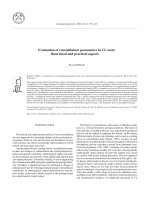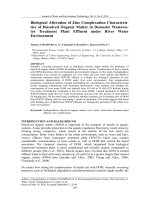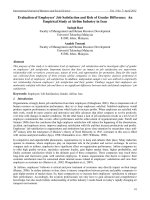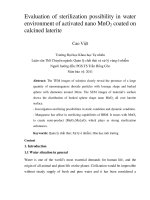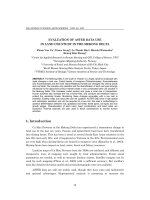Evaluation of sterilization possibility in water environment of activated nano mno2 coated on calcined laterite
Bạn đang xem bản rút gọn của tài liệu. Xem và tải ngay bản đầy đủ của tài liệu tại đây (1.11 MB, 25 trang )
Evaluation of sterilization possibility in water
environment of activated nano MnO
2
coated on
calcined laterite
Cao Việt
Trường Đại học Khoa học Tự nhiên
Luận văn ThS Chuyên ngành: Quản lý chất thải và xử lý vùng ô nhiễm
Người hướng dẫn: PGS.TS Trần Hồng Côn
Năm bảo vệ: 2011
Abstract: The TEM images of solution clearly reveal the presence of a large
quantity of nanomanganese dioxide particles with lozenge shape and barked
sphere with diameters around 30nm. The SEM images of material’s surface
shows the distribution of barked sphere shape nano MnO
2
all over laterite
surface.
- Investigation sterilizing possibilities in static condition and dynamic condition.
- Manganese has affect in sterilizing capabilities of BRM. It reacts with MnO
2
to create semi-product [MnO
2
.Mn].nO
2
which plays as strong sterilization
substances.
Keywords: Quản lý chất thải; Xử lý ô nhiễm; Hóa học môi trường
Content
1. Introduction
1.1 Water situation in general
Water is one of the world’s most essential demands for human life, and the
origin of all animal and plant life on the planet. Civilization would be impossible
without steady supply of fresh and pure water and it has been considered a
plentiful natural resource because the sensitive hydrosphere covers about 75% of
the Earth's surface. Its total water content is distributed among the main
components of the atmosphere, the biosphere, oceans and continents. However,
97% of the Earth's water is salty ocean water, which is unusable for most human
activities. Much of the remaining 3% of the total global water resource, which is
fresh-water, is locked away in glaciers and icebergs. Approximately 20% of the
freshwater resources are found as groundwater, and only 1% is thought to be
easily accessible surface water located in biomass, rivers, lakes, soil moisture,
and distributed in the atmosphere as water vapor. [1]
In the process of rapid development of science and technology, the demand for
pure water is increasing to serve multifarious purposes in different types of
industries. Global water consumption raised six folds in the past century, double
the rate of population growth. In addition, the boom in world’s population during
recent decades, has contributed to the dramatically rising demand of pure water
usage for both household and industrial purposes. The high population density
and industrialization speed have triggered the hydrosphere to be polluted with
inorganic and organic matters at a considerable rate. Moreover, to satisfy the
food demand, a number of harmful chemicals such as pesticides and herbicides
are used in order to improve the productivity in agricultural production, which
also causes the scarcity of clean resources. [1]
1.2 Water sterilization
Water sterilization technology is useful in various ways for our daily life. For
example, it is used in water and sewerage systems treatment. Methods commonly
used for sterilization include chemicals, heat, ultraviolet (UV) radiation, and
ozone. Chemicals (chlorine, peroxide, etc.) are utilized extensively for
sterilization because of their simplicity; however, they probably form unexpected
effects, such as modifying the quality of the target. In addition, sterilization by
chlorine usually generates odorous substances and bio-hazardous materials. [2]
1.2.1 Boiling
The main disadvantage of this method is that it requires a continuous source of
heat and appropriate equipment.
1.2.2 Chlorine
The drawback of this method is that it the storage of chlorine and its use must
need careful handling, large chlorine residual may cause bad taste.
1.2.3. Ozone
The disadvantage of this method is the high cost for operation.
1.2.4 Ultraviolet light
The main disadvantage to the use of UV radiation is that, like ozone treatment, it
leaves no residual disinfectant in the water. Because neither ozone nor UV
radiation leaves a residual disinfectant in the water, it is sometimes necessary to
add a residual disinfectant after they are used. This is often done through the
addition of chloramines, discussed above as a primary disinfectant. When used in
this manner, chloramines provide an effective residual disinfectant with very few
of the negative aspects of chlorination. [6]
1.2.5 Hydrogen peroxide
Hydrogen peroxide (H
2
O
2
) works in a similar way to ozone. Activators such as
formic acid are often added to increase the efficacy of disinfection. It has the
disadvantages that it is slow-working, phytotoxic in high dosage, and decreases
the pH of the water it purifies. [6]
1.2.6 Solar disinfection
One low-cost method of disinfecting water that can often be implemented with
locally available materials is solar disinfection (SODIS). It partially relies on the
ultraviolet radiation that is part of sunlight. Unlike methods that rely on
firewood, it has low impact on the environment. [6]
1.2.7 Photocatalysis on semiconductors
The processes of heterogeneous photocatalysis on semiconductors, developed
during the last twenty years, were firstly regarded as potential methods for
hydrogen photoproduction from water. However, even at the very beginning of
their development, some papers appeared which dealt with photooxidation of
organic and some inorganic (e.g. CN
-
ions) compounds. For more than ten years
the interest of scientists has turned into application of the heterogeneous
photocatalytic methods to water detoxification. [6]
1.2.8 High speed water sterilization using one-dimensional nanostructures
One-dimensional nanostructures have been extensively explored for a variety of
applications in electronics, energy and photonics. Most of these applications
involve coating or growing the nanostructures on flat substrates with
architectures inspired by thin film devices. It is possible, however, to make
complicated three-dimensional mats and coatings of metallic and semiconducting
nanowires, as has been recently demonstrated in the cases of superwetting
nanowire membranes and carbon nanotube (CNT) treated textiles and filters.
Silver nanowires’ (AgNWs) and CNTs’ have unique ability to form complex
multiscale coatings on cotton to produce an electrically conducting and high
surface area device for the active, high-throughput inactivation of bacteria in
water. [6]
1.3 Nanotechnology
Nanotechnology is the science of the small; the very small. It is the use and
manipulation of matter at a tiny scale. At this size, atoms and molecules work
differently, and provide a variety of surprising and interesting uses.
The prefix of nanotechnology derives from ‘nanos’ – the Greek word for dwarf.
A nanometer is a billionth of a meter, or to put it comparatively, about 1/80,000
of the diameter of a human hair. Nanotechnology should not be viewed as a
single technique that only affects specific areas. It is more of a ‘catch-all’ term
for a science which is benefiting a whole array of areas, from the environment, to
healthcare, to hundreds of commercial products.
Although often referred to as the 'tiny science', nanotechnology does not simply
mean very small structures and products. Nanoscale features are often
incorporated into bulk materials and large surfaces.
Nanotechnology is already in many of the everyday objects around us, but this is
only the start. It will allow limitations in many existing technologies to be
overcome and thus has the potential to be part of every industry:
1.4 Manganese dioxide
Manganese dioxide (MnO
2
) occurs naturally as the mineral pyrolusite, which is
the main ore of manganese and a component of manganese nodules.
In the past decades, Manganese dioxide have been exploited for heavy metal
removal from aqueous media, i.e., heavy metal ions [8], arsenate [9], and
phosphate [10] from natural water has attracted considerable attention, because it
would significantly mediate the fate and the mobility of the target pollutants in
water [11, 12]. For example, Kanungo et al. [12] and Kanungo et al. [13] studied
the sorption of Co(II), Ni(II), Cu(II), and Zn(II) ions on manganese dioxide
particles in the presence of different electrolytes. They found that these toxic
metals can be effectively trapped by manganese dioxide through electrostatic
forces and formation of inner-sphere complexes. The specific properties of
manganese dioxide render it a potential sorbent for heavy metal ion removal
from contaminated water.
Manganese dioxide has high oxidation potential so it can disrupt the integrity of
the bacterial cell envelope through oxidation (similar with Ozone, Chlorine…).
1.5 Laterite
Laterites are residual products, which are formed during prolonged mechanical
and chemical weathering of ultramafic bedrocks at the surface of the earth [14].
It was found that laterite’s profiles depend on the conditions of weathering
intensities, geotectonic zones and the parent rock’s compositions. Laterite is used
to describe soils, ferruginous materials, weathering profiles, and chemical
compositions, which are based on SiO
2
, Al
2
O
3
, and Fe
2
O
3
[15]. Laterite is
categorized as soil which contains up to 60.3% iron [16] and is available in many
tropical regions, such as India, Vietnam, Philippines and China [17-19].
Furthermore, laterite adsorbs other ion and heavy metals, such as fluoride (F),
cesium (Cs), mercury (Hg II) and lead (Pb) [20-22]; in water treatment, laterite
has been found to be effective and feasible as an adsorbent in removing some
heavy metals in contaminated groundwater.
When laterite heated to 420-900
o
C, the removal capacity is even better.
Expanded laterite has special properties such as high porosity (and consequently,
low density), it is chemically rather inert, non-toxic, thus it can be used as
excellent filter aid and as a filler in various processes and materials.
Because of it low specific surface area and acidic surface, expanded laterite was
found to be of limited use as an adsorbent for bacterial removal on its own, but it
can be utilized as an appropriate carrier material. On the other hand,
nanoparticles MnO
2
have a large surface area and high oxidation potential which
make them excellent candidates for the bacterial removal in general.
2. Objectives and Research methods
2.1 Objectives
When materials possess nanoparticle size, they will have special properties
in chemical, physical, adsorption and electrode, etc. Therefore, the research
objectives are addressed as follows:
- To synthesize MnO
2
nanoparticles coated on calcined laterite;
- Analyzing of MnO
2
nanoparticles formation portion and its physical structure;
- To investigate the sterilization possibilities of created material;
- To examine the mechanism of sterilization of MnO
2
coated on calcined laterite
in water.
2.2 Materials and Research methods
2.2.1 Material and instruments
All chemicals were reagent grade and they were used without further
purification. Laterite ore was taken from coal and baked at 900
o
C. Potassium
permanganate (KMnO
4
), ethanol, sodium hydroxide (NaOH, 98%), and
hydrogen peroxide (H
2
O
2
) were made in China. Agar was purchased from Ha
Long company, endo agar from Merck. Petri disks, distilled water and others
instruments which were used in the experiment, taken from Faculty of Chemistry
lab equipment.
For structural characterization, the samples were taken to use Transmission
Electron Microscopy (TEM) operated at 80kV. Surface analysis was done using
Scanning Electron Microscope (SEM) (Hitachi S-4800) in National Institute of
Hygiene and Epidemiology.
2.2.2 Research methods
2.2.2.1 Synthesis of nano MnO
2
adsorbents
According to Environmental Protection Agency (EPA) [23], particles are
classified regarding to size: in term of diameter, coarse particles cover a range
between 10,000 and 2,500 nanometers. Fine particles are size between 2,500 and
100 nanometers. Ultrafine particles, or nanoparticles are sized between 100 and
1 nanometers. Therefore, our goal is to create particles which have the size
between 100 and 1 nanometers.
The MnO
2
nanoparticles were synthesized using potassium permanganate
(KMnO
4
) as a precursor using a slight modification of method [24] in the
following way: stirring vigorously a 100ml water:ethanol (1:1, v/v) solution
using magnetic stirrer at room temperature for 10 min, and then the solution was
added 5ml of KMnO
4
0.05M, stirring steady then put slowly H
2
O
2
until brown
black color appears (around 10ml H
2
O
2
10%). Finally, colloidal nano MnO
2
solution was taken for analyzing of nanoparticles formation portion and coating
on calcined laterite.
To synthesize laterite/MnO
2
, the dried calcined laterite, which was grained with
size of 0.1 – 0.5 mm diameter, was poured into MnO
2
nanoparticles solution with
the volumetric portion of solid and liquid was 1/1. The soaking time was 8 to 24
hours. Then the liquid phase was drained off. Solid phase was washed out of
dissolved ions and dried to get bacterial removing material (BRM).
2.2.2.2 Structural characterization
For structural characterization, the samples were taken to use Transmission
Electron Microscopy (TEM) operated at 80kV. TEM is a microscopy technique
whereby a beam of electrons is transmitted through an ultra thin specimen,
interacting with the specimen as it passes through. An image is formed from the
interaction of the electrons transmitted through the specimen; the image is
magnified and focused onto an imaging device, such as a fluorescent screen, on a
layer of photographic film, or to be detected by a sensor. [25]
Surface analysis was done using Scanning Electron Microscope (SEM). The SEM
uses a focused beam of high-energy electrons to generate a variety of signals at
the surface of solid specimens. The signals that derive from electron-sample
interactions reveal information about the sample. [26]
2.2.2.3 Investigation of sterilizing capability of nano MnO
2
adsorbents
The routine monitoring of the bacteriological quality of drinking water relies on
the use of the indicator organisms Escherichia coli (E. coli) and coliforms which
are used to indicate fecal contamination or other water quality problems such as
failures of disinfection, bacterial regrowth within the distribution system or
ingress.
The most commonly employed technique for the detection of these organisms in
water is membrane filtration. Normally, water (100ml) is concentrated by
membrane filtration and the membranes placed onto a selective and differential
medium such as Endo agar [27] which inhibits the growth of gram positive
bacteria. Appropriately diluted (10
-2
) sample (100mL in volume) volumes were
filtered through 0.45µm membrane filters. Plates were then incubated for 24h at
37
o
C on endo agar for total coliform.
The bacteria number was determined in initial water sample and followed the
time of sterilizing process.
The experiments were performed in the static condition as well as the dynamic
condition to estimate the sterilizing capability of MnO
2
nanoparticles.
Specifically, contact time and the ratio between material and water sample were
chosen as fundamental parameters. Therefore, other parameters which affect the
alteration of contact time and the ratio between material and polluted water
sample, such as the column height, the flow rate, etc in the dynamic condition,
were taken into consideration.
2.2.2.4 Examine the mechanism of sterilization of MnO
2
coated on calcined
laterite in water
There are two main purposes in this part: One is to examine whether the
mechanism of sterilization of MnO
2
coated on calcined laterite is influenced by
the high oxidation potential of MnO
2
. The other is to survey the effects of Mn
2+
on sterilizing process of MnO
2
by changing the concentration of Mn
2+
.
Chapter 3
RESULTS AND DISCUSSION
3.1 Synthesis of nano MnO
2
adsorbents
The coating process was carried out as shown in Figure 3.
Figure 1: Coating process
The TEM images of MnO
2
nanoparticles solution clearly reveal the presence of a
large quantity of nanoparticles and assemble to form barbed sphere shape with
the diameter approximately 30nm (as shown in Figure 4-6)
Soaking
Sucking excess liquid
Drying
Washing
Drying
Dried laterite grains
Nano solution
Figure 2: MnO
2
nanoparticles with the magnification of 100000 times
A: Before coating B: After coating
Figure 7: Creation of adsorbent coating by nano MnO
2
particles (100k)
A: Before coating B: After coating
Figure 3: Creation of adsorbent coating by nano MnO
2
particles (200k)
On SEM images in the same scale, it is easy to recognize different surface
pictures of the material before and after coating MnO
2
nanoparticles. Before
coating, the surface of laterite was quite smooth; but after coating there were
nanoparticles of MnO
2
in barbed sphere shape distributed tight all over laterite
surface.
The clinging of MnO
2
nanoparticles on calcined laterite surface was recognized
for application purpose, but the essence of this phenomenon was not determined
so far. There may were any chemical bond, what was binding energy, was there
reformation of nanoparticles or inactivation, etc. That confusion should be
investigated in following time.
3.2 Investigation of sterilizing capability of nano manganese dioxide
In this research, total coliform was chosen as indicating bacteria for all bacterial
removing investigation. The bacteria number was determined in the initial water
sample and followed the time of sterilizing process.
Static and dynamic condition were chosen to conduct the experiments.
3.2.1 Investigation in static condition
3.2.1.1 Influence of detention time on bacteria sterilizing
Detention time is an important parameter to determine the sterilizing ability. In
this experiment, the raw water was treated, diluted then the material is poured
into polluted water in conical beakers with the phase ratio of
solid:liquid=2g:100ml (BRM:polluted water). Next, they are shaken up by
shaking table. The time increased along the row of 10, 20, 30, 40, 50, 60
minutes. Afterwards, all the samples are filtered and determined the bacteria
amount. The results are shown in Table 1, Figure 11-12.
Table 1: Influence of contact time on bacteria sterilizing
Sample
1
2
3
4
5
6
7
8
Detention time (mins)
10
20
30
40
50
60
70
80
Bacteria colony (MPN/100mL)
56
28
0
0
0
0
0
0
Figure 4: Samples in contact time’s influence experiment
Figure 12 shows that when the detention time is lower than 30 minutes, the
bacteria do not have enough time to approach to BRM, so the efficiency would
be undesirable (56 and 28). If the detention time is longer than 30 minutes, all
bacteria would contact to the BRM and be killed. Therefore, the optimal
detection time is 30 minute.
3.2.1.2 Influence of the ratio of BRM and water on bacteria sterilizing
The ratio of BRM and water is important parameter since it represents the
effectiveness of the materials. Moreover, if the ratio is low, this may indicate that
the BRM consumption is small and we can save material. At this experiments,
the detention time was chosen as previous result. And the ratio of BRM/polluted
water increased along the row 0.25/100, 0.5/100, 1/100, 1.5/100, 2/100 g/mL.
The results of experiments are shown in Table 2, Figure 13-14.
Table 2: Influence of the ratio of BRM and water on bacteria sterilizing
0
50
100
150
200
250
10
20
30
40
50
60
70
80
Bacteria colony number
(MPN/100ml)
Contact time (min)
Without treatment
Sample
1
2
3
4
5
BRM/polluted water (g/mL)
0.25/100
0.5/100
1/100
1.5/100
2/100
Bacteria colony (MPN/100ml)
154
21
5
0
0
Figure 5: Samples in BRM/water ratio’s influence experiment
In the first sample, the bacteria colony number is very high (154) at the ratio of
0.25/100. When the ratio increases to 0.5/100, the bacteria number decreases
dramatically to 21. This happens as the amount of BRM in the second sample is
higher than that of the first one, which leads to more chances for bacteria to
contacting with BRM. Figure 14 shows the optimal amount of BRM is 1.5g per
100ml water.
3.2.2 Investigation in dynamic condition
The parameters such as flow rate and the height of BRM column were tested to
see their influence on the sterilizing capability.
3.2.2.1 Influence of flow rate on bacteria sterilizing in BRM column
The raw water was treated, diluted then transferred to a 2L tank. The flow rate
was controlled by input and output valves.
0
50
100
150
200
250
300
0.25/100
0.5/100
1/100
1.5/100
2/100
Bacteria colony number
(MPN/100ml)
BRM/V polluted water
(g/ml)
Without treatment
The flow rate of water column increased along the row of 1, 2.2, 2.8, 3, 4, 5
ml/min (0.18, 0.39, 0.5, 0.53, 0.71, 0.88 mL/min.cm
2
).
The diameter of column is 1.8cm; the height of material is 5cm.
The results of this investigation are given in Table 3, Figure 16-17
Figure 6: Model of column device
Table 3: Influence of flow rate on bacteria sterilizing in BRM column
Sample
1
2
3
4
5
6
Flow rate (ml/min.cm
2
)
0.18
0.39
0.5
0.53
0.71
0.88
Bacteria colony (MPN/100mL)
0
0
0
12
56
140
Figure 7: Influence of flow rate on bacteria sterilizing in BRM column
The amount of total coliform in sample 4, 5 and 6 is 12, 56 and 140 MPN/100mL
respectively. Those results mean that the bacteria had not been killed effectively
due to the lack of contact time between bacteria and MnO
2
.
If the flow rate is 0.53mL/min.cm
2
, the analysis result shows that there is still
12MPN/100ml available. Even the removal capacity increased remarkably, it
still did not meet the drinking water standard of Environmental Protection
Agency [28].
When the flow rate decreases to 0.5mL/min.cm
2
or lower, the sterilizing
capability is complete.
Figure 17 indicates that the slower the flow rate is, the better sterilizing is
achieved. For the optimal flow rate, 0.5 mL/min.cm
2
will be chosen for the next
experiments.
3.2.2.2 Influence of column height on bacteria sterilizing in BRM column
The raw water was treated, diluted then transferred to the 2L tank. The flow rate
was controlled by input and output valves.
The height of material column increased along the row of 1, 2, 3, 4, 5 cm.
0
50
100
150
200
250
300
0.18
0.39
0.5
0.53
0.71
0.88
Bacteria colony number
(MNP/100ml)
Flow rate
(ml/min.cm2)
The diameter of column is 1.8cm; the flow rate is 0.5ml/min.cm
2
.
The results are given in Table 4, Figure 18-19.
Table 4: Influence of column height on bacteria sterilizing in BRM column
Column height (cm)
1
2
3
4
5
Bacteria colony (MPN/100mL)
250
100
10
0
0
Figure 8: Influence of column height on bacteria sterilizing in BRM column
The amount of total coliform in the sample 1 and 2 were 250 and 100
MPN/100mL respectively. The results mean that the bacteria had not been killed
effectively because of the insufficiency of contact time between bacteria and
MnO
2
(the column height is not long enough).
If the height is 3cm, the analysis result shows that there is still 10MPN/100ml
available. Even the removal capacity increased remarkable but it still did not
meet the EPA drinking water standard [28].
When the height increases to 4cm or higher, the sterilizing capabilities is
completely.
0
50
100
150
200
250
300
350
1
2
3
4
5
Bacteria colony number
(MNP/100ml)
Column height
(cm)
It is apparent that the height of BRM column and the flow rate of water strongly
influence the sterilizing ability. The sterilizing ability of column increases along
with the increase of the BRM layer height. In contrast, it decreases when the flow
rate increases.
At current time, in many published reports, authors used parameter EBCT
(Empty Batch Contact Time) for characterization of both of column filter
parameters above.
EBCT =
𝑉𝑜𝑙𝑢𝑚𝑒 𝑜𝑓 𝑀𝑎𝑡𝑒 𝑟𝑖𝑎𝑙 𝑠ℎ𝑎𝑝𝑒 (𝑐𝑚
3
)
𝐹𝑙𝑜𝑤 𝑟𝑎𝑡𝑒 (
𝑚𝐿
𝑚𝑖𝑛
)
=
𝑉
𝑞
From the results, V = πR
2
h = 3.14 x 0.9
2
x 4 = 10.17 cm
3
q = 2.8 mL/min
So EBCT =
10.17
2.8
= 3.63 mins
In the case of the investigation, the minimum EBCT for safely bacterial
sterilizing is 3.63 min.
3.3 Mechanism of sterilization of MnO
2
coated on calcined laterite in water
3.3.1 Investigation the influence of Mn
2+
in sterilizing capability
The experiment was performed to analysis the influence of Mn
2+
on water
sterilizing capability of MnO
2
nanoparticles.
The four different concentrations which are ranging 0.1, 1 and 10 ppm of Mn
2+
were put into water samples with the available of MnO
2
nanoparticles material.
The processes were conducted in static condition (100mL waste water was
treated by 0.5g BRM; contact time was 10 minutes; initial MPN in wastewater
was 380). The results are shown in Table 5, Figure 20-21.
Table 5: Influence of Mn
2+
in sterilizing capabilities
Sample
1
2
3
4
Mn
2+
added (ppm)
0
0.1
1
10
Bacteria colony
(MPN/100ml)
63
36
15
0
Figure 9: Influence of Mn
2+
in sterilizing capabilities
Figure 21 illustrates that the Mn
2+
added in samples affects dramatically on the
sterilizing capability, from 60 MPN/100ml of no Mn
2+
to 0 MPN/100ml of
10ppm Mn
2+
.
Consequently, MnO
2
added Mn
2+
have better sterilization possibility than MnO
2
itself. In other words, ion manganese (II) has been shown to have effects on the
sterilizing capability of BRM.
3.3.2 Examine the mechanism of sterilization of MnO
2
The mechanism of MnO
2
for bacterial removal is still unclear. Therefore, a
mechanism of the process was proposed as follows:
1. MnO
2
attached (attacks) on bacteria cell as Figure 22:
0
50
100
150
200
250
300
350
400
0
0.1
1
10
Bacteria colony number
(MPN/100ml)
Mn2+ added
(ppm)
Without treatment
Figure 10: Bacteria destruction
- A healthy bacillus bacterial cell.
- Zooming in closer, MnO
2
(light green) comes into contact with the cell wall.
The cell wall is vital to the bacteria because it ensures the organism can maintain
its shape.
- As MnO
2
molecules make contact with the cell wall, a reaction called an
oxidative burst occurs which literally creates a tiny hole in the cell wall.
- A new hole created in the cell wall has injured the bacterium.
- The bacterium begins to lose its shape while MnO
2
molecules continue
creating holes in the cell wall.
- After thousands of MnO
2
collisions over only a few seconds, the bacterial
wall can no longer maintain its shape and the cell dies.
2. As can be seen from the previous results, ion manganese (II) has been
shown to have effects on the sterilizing capability of BRM. Therefore, the
mechanism could be as follow:
MnO
2
+ Mn
2+
→ [MnO
2
.Mn]
2+
(1)
[MnO
2
.Mn]
2+
+ nO
2
→ [MnO
2
.Mn].nO
2
(2)
[MnO
2
.Mn].nO
2
→ 2MnO
2
+ (n-1)O
2
(3)
Disintegration process of semi-product [MnO
2
.Mn].nO
2
appeared trivalent or/and
pentavalent Mn – high oxidation potential and very active species. These species
play as strong sterilization substances.
Therefore, in some circumstances, some raw water resources with Mn
2+
pollution
will have better performance in treating by nano MnO
2
adsorbent.
4. Conclusions
- The nano MnO
2
solution was prepared as 2.2.2.1. The TEM images of solution
clearly reveal the presence of a large quantity of MnO
2
nanoparticles with
lozenge shape and barked sphere with the diameters around 30nm.
- The BRM was prepared from calcined laterite and nano MnO
2
solution. The
SEM images of material’s surface shows the distribution of barked sphere shaped
nano MnO
2
all over laterite surface.
- Sterilizing possibilities is under the static condition was studied. The detention
time selected is 30 minute, and the preferable ratio of BRM/polluted water is
1.5g:100mL.
- Water can sterilize by means of use BRM as column filter. All bacteria in water
could safely exterminate when flowing through column filter with the minimum
layer height of BRM 4cm and the maximum flow rate 0.5ml/min.cm
2
or EBCT
was guaranteed at least 3.6 minutes. Both MnO
2
nanoparticles solution and BRM
were non toxic and economic, so they have a high potential to be applied for
water sterilizing in water plants as well as at household scale.
- Ion manganese (II) affects the sterilizing capability of BRM. It reacts with
MnO
2
to create semi-products [MnO
2
.Mn].nO
2
which play as strong sterilization
substances.
- The research obtains some positive results in creating a new material for
wastewater sterilization, which may account for the global effort of saving clean
water resources – which is currently one of the most concerning issues not only
in Vietnam but also in other countries. However, in order to apply those study
results in the real world, it is still required further investigations on the
mechanism and the harms of manganese dioxide to water after treatmen
REFERENCES
1. Van der Bruggen, B., C.E. Isabel, and I.S. Andrea, Chapter 3 The Global Water
Recycling Situation, in Sustainability Science and Engineering, Elsevier. p. 41-62.
2. Jan Davis, R.L., Engineering in emergencies – A practical guide for relief workers.
2nd ed. 2002.
3. Water storage tips to assist in emergency preparedness. 2010, Water Quality and
Health Councils
4. Conan, J., Water for life – community water security. 2005.
5. Keystone, J.S.R., S. R., International travel health guide. 2008.
6. Block, S.S., Disinfection, sterilization, and preservation. 2001: Lippincott
Williams and Willkins.
7. Mark A. Ratner, D.R., Nanotechnology: a gentle introduction to the next big idea.
2003: Pearson Education.
8. Mishra, S.P., S.S. Dubey, and D. Tiwari, Inorganic particulates in removal of
heavy metal toxic ions: IX. Rapid and efficient removal of Hg(II) by hydrous
manganese and tin oxides. Journal of Colloid and Interface Science, 2004. 279(1):
p. 61-67.
9. Takamatsu, T., M. Kawashima, and M. Koyama, The role of Mn2+-rich hydrous
manganese oxide in the accumulation of arsenic in lake sediments. Water
Research, 1985. 19(8): p. 1029-1032.
10. Kawashima, M., et al., Phosphate adsorption onto hydrous manganese(IV) oxide
in the presence of divalent cations. Water Research, 1986. 20(4): p. 471-475.
11. Tripathy, S.S., J L. Bersillon, and K. Gopal, Adsorption of Cd2+ on hydrous
manganese dioxide from aqueous solutions. Desalination, 2006. 194(1-3): p. 11-
21.
12. Kanungo, S.B., et al., Adsorption of Co2+, Ni2+, Cu2+, and Zn2+ onto
amorphous hydrous manganese dioxide from simple (1-1) electrolyte solutions.
Journal of Colloid and Interface Science, 2004. 269(1): p. 11-21.
13. Kanungo, S.B., S.S. Tripathy, and Rajeev, Adsorption of Co, Ni, Cu, and Zn on
hydrous manganese dioxide from complex electrolyte solutions resembling sea
water in major ion content. Journal of Colloid and Interface Science, 2004. 269(1):
p. 1-10.
14. Eliopoulos, D.G.a.M.E E., Geochemical and Mineralogical Characteristic of Fe-
Ni and Bauxite Laterite Deposits of Greece. Ore Geo Reviews, 2000. 16: p. 41-58.
15. Bourman, R.P.a.C.D.O., A Critique of the Schellmann: Definition and
Classification of Laterite. Catena 2002. 47: p. 117-131.
16. Mamindy-Pajany, Arsenic adsorption onto hematite and goethite Comptes Rendus
Chimie, 2009. 12(8): p. 876-881.
17. S.V., D., Removal of arsenic from synthetic groundwater by adsorption using the
combination of laterite and iron-modified activated carbon. Journal of Water and
Environment Technology 2008. 6(1): p. 43-54.
18. Liu, K., Chen, Q., Hu, H., Yin, Z. and B. Wu, Pressure Acid Leaching of a
Chinese Laterite Ore Containing Mainly Maghemite and Magnetite.
Hydrometallurgy In Press.
19. Mohapatra, M., Khatun, S. and S. Anand, Kinetics and Thermodynamics of Lead
(II) Adsorption on Lateritic Nickel Ores of Indian Origin. Chem. Eng. J., 2009.
155: p. 184-190.
20. Yu, X., Zhu, L., Guo, B. and S. He, Adsorption of Mercury on Laterite from
Guizhou Province, China. J. Environ. Sci., 2008. 20: p. 1328-1334.
21. Johnson, M.C., Wang, J., Li, Z., Lew, C. M. and Y. Yan, Effect of Calcination and
Polycrystallinity on Mechanical Properties of Nanoporous MFI Zeolites. Mater.
Sci. Eng., 2007. 456: p. 58-63.
22. Sarikaya, Y., Sevinç, I. and M. Akinç, The Effect of Calcination Temperature on
Some of the Adsorptive Properties of Fine Alumina Powders Obtained by
Emulsion Evaporation Technique. Powder Technol, 2001. 116: p. 109-114.
23. EPA, Module 3: Characteristics of Particles - Particle Size Categories
24. Cuong, L.M., Tổng hợp và đánh giá khả năng hấp thụ asen, kim loại nặng
của hỗn hợp đồng kết tủa sắt hiđrôxit, mangan điôxit kích cỡ nanomet
trên chất mang laterit và cố định MnO
2
có kích cỡ nanomet trên chất mang
laterit 2010, HUS.
25. Williams, D.B. and C.B. Carter, The Transmission Electron Microscope
Transmission Electron Microscopy. 2009, Springer US. p. 3-22.
26. Goldstein, J., Scanning electron microscopy and x-ray microanalysis. 2003:
Kluwer Adacemic/Plenum Pulbishers. 689.
27. Thi, N.T., Nghiên cứu điều chế dung dịch Ag nano mật độ cao, ứng dụng trong
chế tạo vật liệu tiệt trùng nước. 2009.
28. EPA, National Primary Drinking Water Regulations, in Total coliforms.
